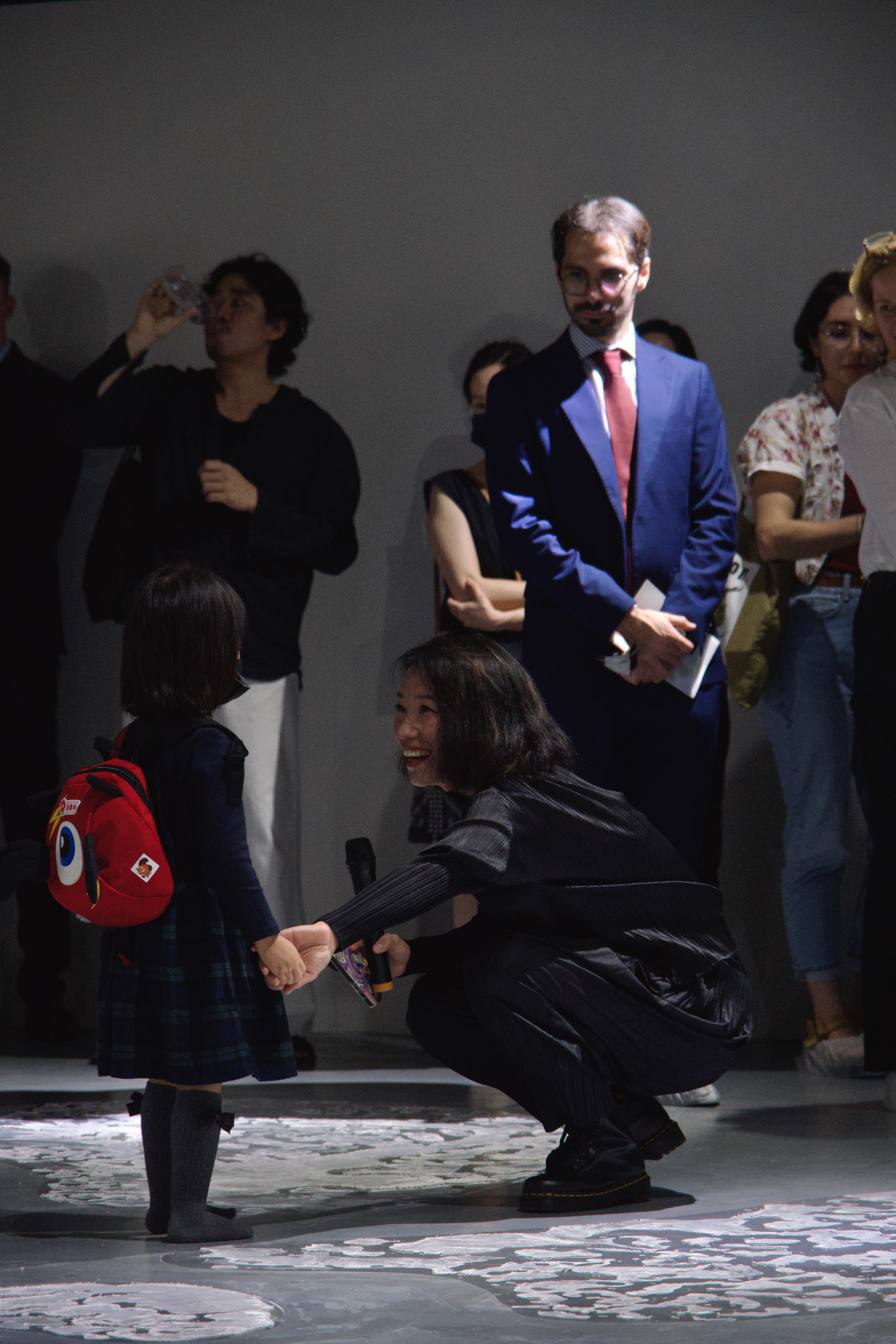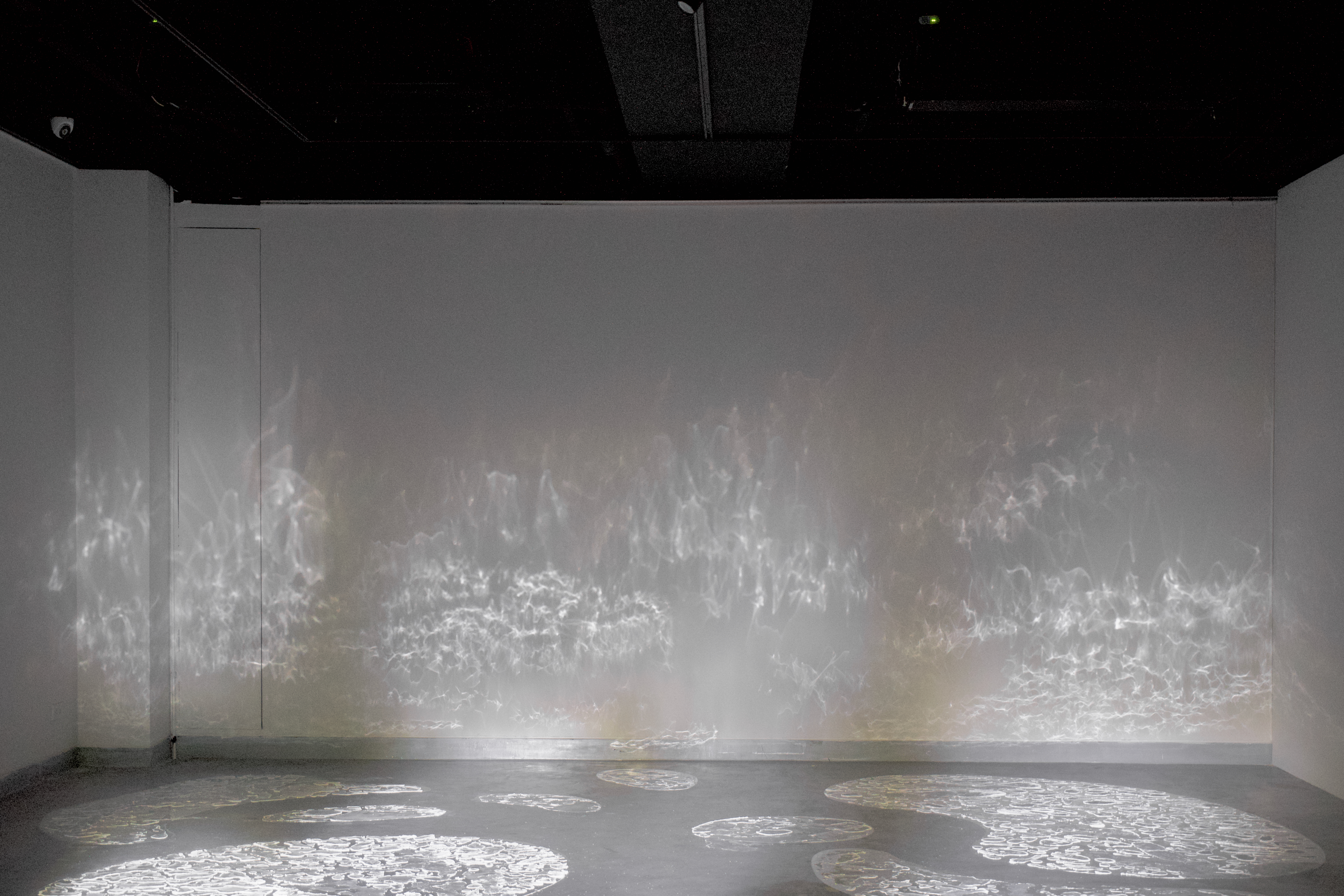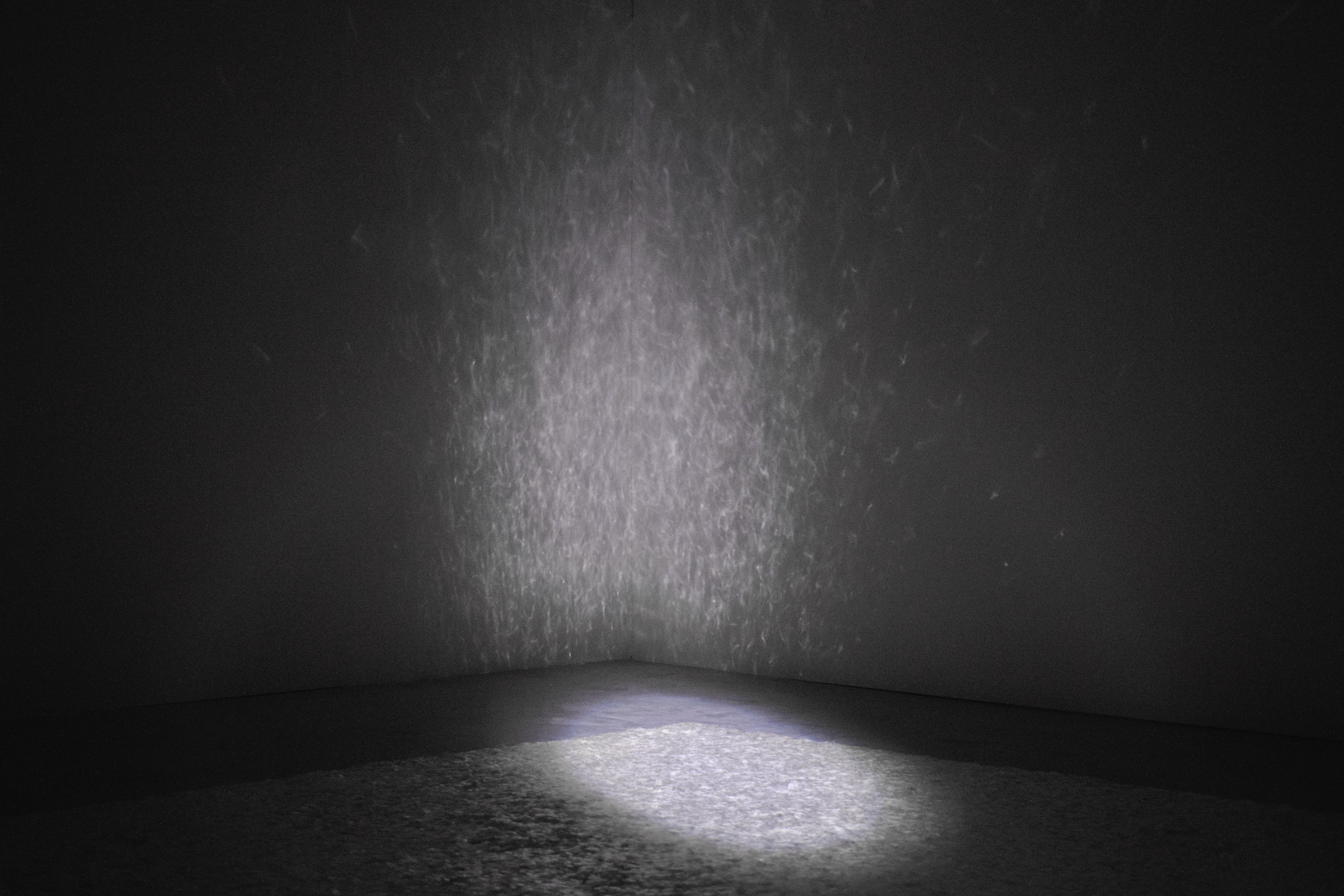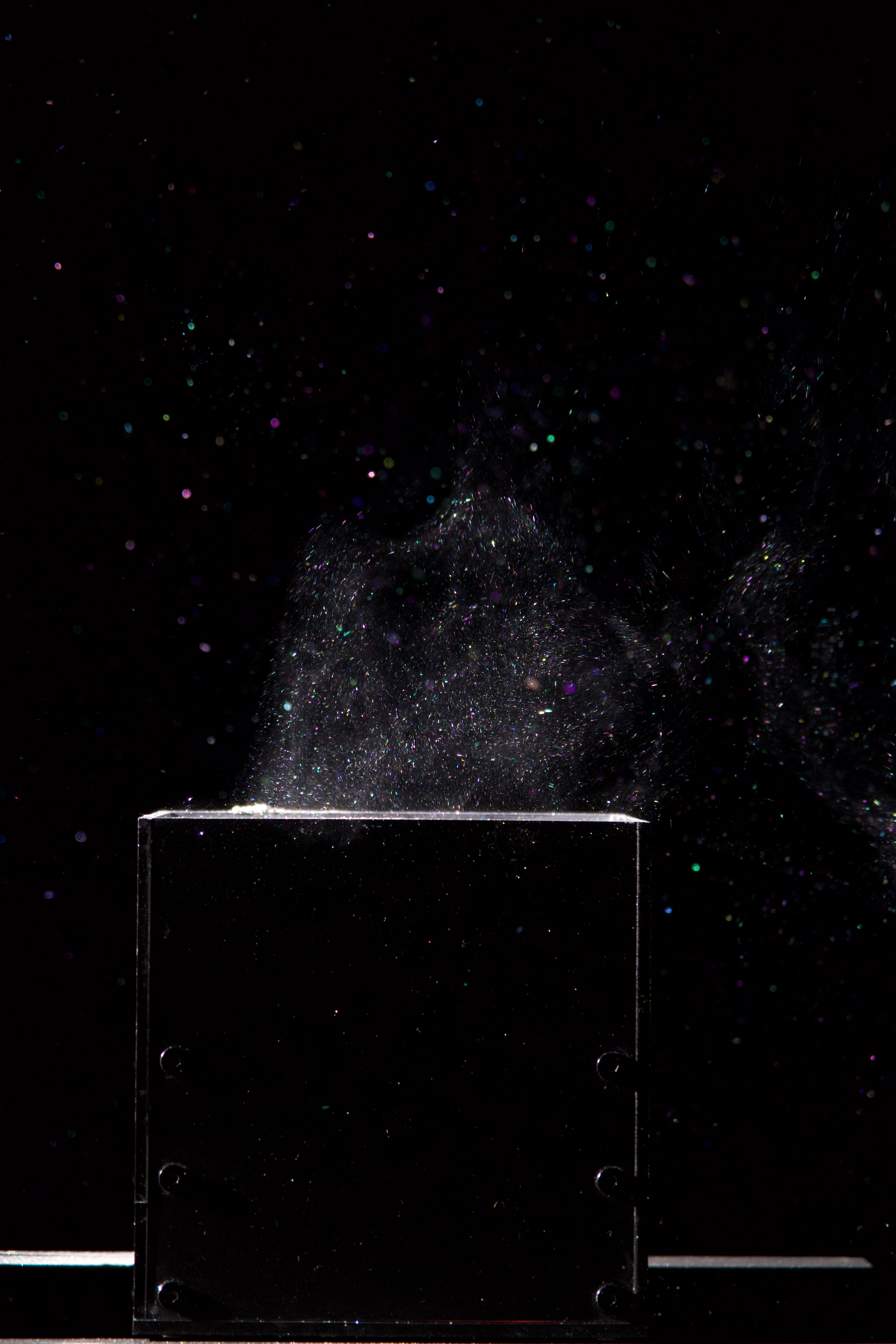OPEN HOURS:
Tuesday - Saturday 11AM - 6PM
Close on Sunday, Monday and Pubilc Holidays
For more information: info@sac.gallery

(English is below)
ไม่ต่างกับศิลปินอีกหลายๆ คนที่เรารู้จัก จาจา ฉี (Jiajia Qi) คือศิลปินที่ไม่เคยอยู่ติดที่ เธอตระเวนทำงานมาแล้วหลายประเทศทั่วโลก ไม่ว่าจะเป็นนิวซีแลนด์ อียิปต์ และญี่ปุ่น ฯลฯ ชีวิตของเธอเคลื่อนที่อยู่ตลอดเวลา ประหนึ่งว่าเส้นเขตแดนในแผนที่ที่เราเห็นกันนั้น พร่าเลือนจนไม่มีอยู่ในพจนานุกรมชีวิตของเธอ
การเคลื่อนย้ายข้ามพรมแดนไปมาเป็นเหตุให้ศิลปินชาวจีนคนนี้ย้อนกลับมาตั้งคำถามถึง “ความจริง” ที่เรายึดถือกันนั้น กำหนดขึ้นจากบริบททางสังคมและประวัติศาสตร์ที่คุ้นเคยมากแค่ไหน และการติดอยู่ในกรอบคิดที่มีรูปร่างเหมือนประเทศที่อาศัยอยู่นั้น จำกัดความเป็นไปได้ใหม่ๆ มากน้อยเพียงใด
นั่นทำให้เธอนำ “กรอบความคิดแบบเร่ร่อน” หรือ “Nomadic Thought” แนวคิดที่ว่าด้วยการไม่ยึดติดอยู่กับที่ทั้งเชิงกายภาพและความคิด กลับกันยังสามารถแปรเปลี่ยนเคลื่อนไหวได้อยู่ตลอดเวลา ซึ่งมาจากนักปรัชญาชาวฝรั่งเศสอย่าง ฌียส์ เดอเลอซ (Gilles Deleuze) และ เฟลิกซ์ กัตตารี (Félix Guattari) เข้ามาใช้สร้างสรรค์ผลงานศิลปะและนิทรรศการครั้งนี้

“การข้ามพรมแดน ไม่ได้อยู่ที่ใดที่หนึ่งถาวร แต่เป็นการเคลื่อนไหวจากตรงนี้ไปตรงนั้น มันคือความลื่นไหล การก้าวข้ามสิ่งที่ถูกตรึงไว้แล้วอย่างประเทศ รัฐ หรือโครงสร้างที่ตายตัว ฉันมองว่ามันเหมือนการเล่นหมากรุกจีน ที่ตัวหมากขาว-ดำไม่มีตัวตนถาวร
“สิ่งสำคัญคือการเคลื่อนไหว นี่แหละคือความหมายของ Nomadic สำหรับฉัน”
ศิลปินหญิงตรงหน้าสังเขปแนวคิดที่เธอนำมาใช้ทำงานครั้งนี้ ก่อนนำเราเดินเข้าสู่ห้องจัดแสดง ที่ซึ่งเธอพร่าระบบระเบียบทางศิลปะ พาเราสัมผัสกับความวาบไหวของสสารต่างๆ ที่กำลังเคลื่อนตัวใต้แสงเงาสลัว
“Only I Am You, Then I Became You” คือนิทรรศการเดี่ยวครั้งแรกในเอเชียของจาจา ประกอบด้วยผลงานศิลปะจำนวน 8 ชิ้น ทั้งชิ้นเก่าที่เคยจัดแสดงมาแล้ว (กับบางชิ้นที่ไม่เคยแสดงที่ไหน) จำนวน 3 ชิ้น และชิ้นใหม่ที่สร้างขึ้นเพื่องานครั้งนี้โดยเฉพาะอีก 5 ชิ้น กินพื้นที่จัดแสดงถึง 2 ชั้น ของแกลเลอรี กลางมหานครกรุงเทพฯ
“ชื่อก็คือเหมือนงานศิลปะเอง มันให้ความรู้สึกบางอย่าง แต่บอกเป็นคำชัดๆ ได้ยาก เวลาเห็นชื่อนี้คุณอาจจะรู้สึกอะไรบางอย่าง แต่ก็ยากที่จะอธิบาย” ศิลปินเล่าถึงชื่อนิทรรศการครั้งนี้ ก่อนย้อนความกลับไปตอนที่ย้ายไปอยู่ในต่างแดน ในวัฒนธรรมและภาษาที่ไม่คุ้นเคย เธอพบกับปัญหาเรื่องการสื่อสาร
“ฉันตระหนักว่า ภาษาเมื่ออยู่ในพื้นหลังที่ต่างกันทำงานไม่เหมือนกัน ประสบการณ์ตรงนั้นทำให้ฉันคิดถึงการเล่นกับภาษาเหมือนการสร้างงานศิลปะ
“ชื่อมันเลยให้ความเป็นเฉพาะตัว แต่ก็ไม่ชัดเจนว่ามันคืออะไร เราพยายามแปลเป็นภาษาจีนก็ยังไม่เจอคำที่ตรงเป๊ะ มันพูดถึงคุณและฉัน แต่ยังเปิดกว้าง และเชื่อมโยงได้หลายแบบ” จาจาอธิบาย

นิทรรศการครั้งนี้ เธอใช้วิธีการจัดแสดงตามแนวทาง “Site-specific” หรือศิลปะที่สัมพันธ์กับพื้นที่เฉพาะ ผสานเรื่องราวเข้ากับสถานที่ และผสานพื้นที่เข้ากับเรื่องเล่า เพื่อชวนตั้งผู้ชมคำถามต่อความสัมพันธ์ระหว่างบริบทของที่จัดแสดง เงื่อนไขทางสิ่งแวดล้อม และประสบการณ์ส่วนบุคคลของผู้ชม ซึ่งไม่มีสิ่งใดจีรัง
จาจาใช้เวลากว่า 2 เดือน ทำงานกับแกลเลอรี มองหาความพอเหมาะพอดี แง่งามตามมุมต่างๆ ของอาคาร เนรมิตห้องจัดแสดงสำหรับแต่ละชิ้นงาน เพื่อให้ตอบสนองกับพื้นที่จัดแสดงโดยตรง และให้งานของเธอดำรงอยู่ร่วมกับอาคารสถานที่อย่างแน่นแฟ้น
“แต่ละที่ก็มีความท้าทายของมัน สำหรับที่นี่ สิ่งสำคัญคือการเข้าใจพื้นที่ เข้าใจระบบของอาคาร และเรียนรู้ที่จะทำงานตามกติกา” เธอเล่าถึงการทำงานแบบ Site-specific
แต่หากถามถึงจุดเริ่มต้นของชิ้นงานต่างๆ ที่ถูกนำมาบรรจุในอาคารครั้งนี้อาจต้องย้อนไปไกลกว่านั้นนับปี
“นี่เป็นหนึ่งในโปรเจกต์ที่ใช้เวลายาวนานที่สุดที่ฉันเคยทำมาเลย” จาจาออกปากถึงนิทรรศการครั้งใหม่
“เริ่มต้นตั้งแต่ต้นปีที่แล้ว ตอนนั้นฉันทำงานที่ปารีส เพื่อนที่สนิทกันมากว่าสิบปีโทรมาหาฉัน แล้วเราก็มีไอเดียจะทำโปรเจกต์นี้ร่วมกัน หลังจากนั้นก็เริ่มคิดว่าจะทำที่ไหน สุดท้ายก็ตัดสินใจทำ และเริ่มติดต่อสื่อสารกัน”
นิทรรศการครั้งนี้จาจาได้ หลินเจี๋ย โจว (Linjie Zhou) ภัณฑารักษ์ชาวจีน ซึ่งเป็นอีกแรงสำคัญเข้ามาช่วยเติมมิติอื่นๆ ที่ยังขาด ทำให้งานครั้งนี้สมบูรณ์แบบยิ่งขึ้น

เธอบอกว่า ครึ่งหนึ่งของผลงานที่จัดแสดงครั้งนี้ผลิตขึ้นในประเทศเนเธอร์แลนด์ ขณะที่อีกครึ่งหนึ่งผลิตที่ประเทศจีน ที่ตั้งใจให้เป็นเช่นนั้นเพราะตลอด 3 ปี ระหว่างโควิด-19 ระบาด เธอไม่ได้กลับไปบ้านเกิด และนั่นนำไปสู่ความคิดถึงและอยากสำรวจว่า บรรยากาศของแวดวงศิลปะร่วมสมัยในเอเชียหลังโรคระบาดเป็นอย่างไร เธอจึงกลับไปทำงานที่จีนอยู่ช่วงหนึ่ง ก่อนกลับไปที่เนเธอแลนด์ และข้ามมาเป็นศิลปินในพำนักกับ SAC Residency ที่จังหวัดเชียงใหม่
ผลงานหลายชิ้นจึงมีสิ่งที่เธอพบเจอมาในเมืองเชียงใหม่เข้ามาเป็นเงาทาบอยู่เบื้องหลัง อย่างในงาน “Who But, Diane” ที่ได้แรงบันดาลใจแสงไฟรอบตัวตั้งแต่เสาไฟไปถึงแสงดาวระยับพรายบนฟ้าที่กระทบลงบนผิวน้ำ ระหว่างเดินเลียบแม่น้ำที่เชียงใหม่ และเฮก เนเธอร์แลนด์ ที่เธอเคยอาศัย
“ฉันชอบเดินไปดูน้ำรอบคูเมืองเชียงใหม่ในเวลาต่างๆ ของวัน เพื่อสังเกตการสะท้อนของแสงธรรมชาติและไฟถนน รวมถึงการไปวัดที่มีน้ำไหลจากป่าเข้าสู่วัด ประสบการณ์เหล่านี้สร้างแรงบันดาลใจมาก
“สตูดิโอที่เชียงใหม่มีดาดฟ้า ทำให้เห็นท้องฟ้า พระอาทิตย์ขึ้น–ตก และเพราะบ้านส่วนใหญ่เตี้ย เลยมองเห็นขอบฟ้าได้กว้าง ความเปิดโล่งนั้นสร้างแรงบันดาลใจให้ฉันมากเช่นกัน” เธอเล่าถึงสารตั้งต้นในการสร้างผลงานที่ประเทศไทย อีกดินแดนที่ได้มาพำนัก
นอกจากนี้ ยังมีผลงานเก่าที่จาจานำมาจัดแสดง ซึ่งล้วนแต่มีความหมายเกี่ยวโยงเข้ากับพื้นที่ที่เธอเคยไปเยือน เช่น “Who Listens, At Dust” ตาข่ายโปร่งใสที่เธอบรรจงหยดสารถักร้อยอย่างประณีต ได้ไอเดียจากเครื่องดักหมอกในประเทศชิลีและตาข่ายดักน้ำจากหมอกที่ลอยผ่าน เพื่อตอบสนองต่อสภาวะฝนที่ตกน้อยในพื้นที่จากภาวะโลกร้อน


รวมถึง “Miles to Go Before I Sleep” และ “For the Listener, Who Listens in the Snow” ที่นำมาโชว์ในกรุงเทพฯ เป็นครั้งแรก
เธอเล่าว่า บางชิ้นสร้างขึ้นตั้งแต่ช่วงที่โควิด-19 ระบาดและล็อกดาวน์ มีน้อยคนที่เคยได้เห็น การนำมาจัดแสดงที่กรุงเทพฯ ครั้งนี้จึงเป็นครั้งแรกที่แสดงในที่สาธารณะ ขณะที่ผลงานชิ้นอื่นๆ เธอก็คัดสรรจากความเชื่อมโยงเข้ากับคอนเซปต์ของนิทรรศการ และบางชิ้นมีการปรับปรุงให้เข้ากับสถานที่จัดแสดง
ประสบการณ์จากการใช้ชีวิตที่เคลื่อนย้ายที่พำนักไปเรื่อยๆ ของศิลปินชาวจีนคนนี้ สะท้อนกลับมาในทุกท่วงท่าในการสร้างสรรค์ผลงาน เชื่อมร้อยเข้ากับความทรงจำที่ผ่านมา และถักทอระหว่างความเป็นตะวันออกกับตะวันตกเข้าด้วยกัน
“ฉันย้ายประเทศหลายครั้ง เติบโตในจีน แล้วย้ายไปเนเธอร์แลนด์ เรียนศิลปะที่นั่น สิ่งที่เรียนรู้มากที่สุดคือการเข้าใจวิธีคิดของคนอื่น การสื่อสารไม่ใช่แค่ภาษาอังกฤษ แต่คือการเข้าใจวิธีคิดให้ตรงกัน
“ช่องว่างตรงนี้ทำให้ฉันเรียนรู้และสังเกตมากขึ้น และกลายมาเป็นส่วนหนึ่งของงานศิลปะ เพราะมันทำให้ตระหนักว่าไม่มีมุมมองที่ตายตัว ทุกสิ่งเปลี่ยนไปตามตำแหน่งที่เรายืนอยู่ สิ่งสำคัญคือการรู้ว่ามีสิ่งที่เรายังไม่รู้ และเปิดรับมัน”
หลังจากเดินผ่านสสารที่อยู่ในสภาวะต่างๆ และแสงเงาไร้รูปทรงในห้องแล้วห้องเล่า เราก็มาถึงห้องสุดท้าย “The Weight of a Whisper” ผลงานจากแผ่น PET ใสบนพื้นห้องค่อยๆ เรืองประกายทันทีที่แสงจากไฟฉายตกกระทบ เธอตั้งใจเปิดโอกาสให้ผู้ชมได้มีปฏิสัมพันธ์กับชิ้นงาน ด้วยการส่องไฟฉายไปที่พื้น แล้วพื้นจะค่อยๆ สะท้อนระยิบ เหมือนกำลังเงยหน้ามองหมู่ดาวบนท้องฟ้า เคลื่อนไหวเปลี่ยนไปมายามแสงไฟย้ายมุม


ในทางหนึ่งดูเหมือนว่า ชิ้นงานต่างๆ ในนิทรรศการครั้งนี้มีความหมายที่แยกแตกต่าง ดำรงอยู่ภายใต้ชุดความหมายที่เป็นปัจเจก ตีความตามแต่อัตวิสัยของผู้ชม แต่ในบางห้วงขณะ พวกมันกลับสนทนาซึ่งกันและกัน และร่วมกันทลายเขตแดนที่แบ่งกั้นแต่ละห้องไว้
“งานเหล่านี้เหมือนพี่น้องกัน พวกมันเชื่อมโยงถึงกันและกัน และเป็นความต่อเนื่อง” เธอว่าสั้นๆ ถึงงานทั้งหมด ก่อนตอบคำถามที่ว่า จริงๆ แล้ว อยากให้ผู้ชมได้รับอะไรกลับไปหลังจากชมงานครั้งนี้
“ความเห็นของคุณในฐานะผู้ชม มีค่าเท่ากับความเห็นของฉันในฐานะศิลปิน ถ้าหลังจากดูงานแล้วกลับบ้านไป วันหนึ่งคุณยังจำได้ และเกิดการเชื่อมโยงไม่ว่ารูปแบบใด แค่นั้นก็พอแล้ว
“เพราะสำหรับฉัน ศิลปะไม่ได้หมายถึงสิ่งที่คุณรู้สึกทันทีเสมอไป แต่มันอาจเกิดขึ้นภายหลัง วันที่คุณนึกย้อนขึ้นมาได้ สิ่งสำคัญคือการตระหนักรู้และการจดจำ” จาจาตกตะกอนความคิดให้ฟัง ก่อนเราจะบอกลาดินแดนไร้รูป ปราศจากเส้นแบ่ง แล้วออกมาสู่โลกที่มักคุ้น

ถึงตัวเราจากไปหรือใครก็ตาม แต่โลกศิลปะที่เธอสร้างขึ้นมายังคงดำรงชีวิตต่ออย่างเงียบเชียบ ท่ามกลางความเคลื่อนไหวของวัสดุ อากาศ สสาร และแสงเงา ซึ่งไล้ผิวทุกคนที่ล่วงเข้าไปผลัดเปลี่ยนเป็นส่วนหนึ่งในงาน เหมือนที่เธอบอกไว้แต่แรก
“เมื่อสร้างเสร็จ มันก็มีชีวิตของมันเอง คล้ายกับการปลูกต้นไม้ ฉันปลูกเมล็ดไว้ที่นี่ มันจะเติบโตไปกับสภาพแวดล้อม ทีมงาน และผู้ชม”

นิทรรศการ “Only I Am You, Then I Became You” ของจาจาจึงไม่ใช่เพียงการจัดแสดงผลงานศิลปะร่วมสมัยทั่วไป หากแต่เป็นการเปิดพื้นที่ให้เราได้ทดลองข้ามพรมแดนอย่างพินิจพิเคราะห์ สัมผัสและรับรู้มวลรอบตัวด้วยความรู้สึกไปพร้อมกับเธอ ศิลปินที่อยู่ไม่เคยติดที่ทั้งทางกายภาพและความคิดคนนี้
Like many artists we know, Jiajia Qi is someone who never stays still. She has lived and worked across the world, from New Zealand and Egypt to Japan and beyond. Her life is one of constant movement, as if the borders on the map we see have blurred and ceased to exist in the dictionary of her life.
This crossing of borders has led the Chinese artist to question the truths we hold on to, how much they are shaped by familiar social and historical contexts, and how the framework of thought we inhabit, often resembling the very nation we live in, can limit new possibilities.
From this reflection, she draws upon the concept of Nomadic Thought, an idea introduced by French philosophers Gilles Deleuze and Félix Guattari that rejects fixed positions, physically and intellectually. Instead, it embraces transformation and movement, remaining in flux. This philosophy underpins her artistic creation and informs this exhibition.

“Crossing borders does not mean belonging permanently anywhere. It is about moving from here to there, a state of fluidity, of transcending what has been fixed such as nations, states, or rigid structures. I see it as a game of Chinese chess, where the black and white pieces never have a permanent identity. What matters is movement. That is what Nomadic means to me.”
With this, the artist sums up the idea behind her work before guiding us into the exhibition space, where artistic order dissolves, and we are invited to feel the subtle pulse of matter shifting beneath dim light and shadow.
“Only I Am You, Then I Became You” marks Jiajia Qi’s first solo exhibition in Asia. It features eight works, three previously shown, some never before seen in Asia, and five newly created pieces, spread across two floors of the gallery in the heart of Bangkok.
“The title feels like the artwork itself. It evokes a certain feeling that is hard to define in words. When you see it, you might sense something, yet it is difficult to explain,” she says, recalling how, after moving abroad into a new culture and unfamiliar language, she struggled to communicate.
“I realised that language works differently depending on its background. That experience made me think of playing with language as a way of creating art. The title feels very personal, yet its meaning remains open. Even when I tried translating it into Chinese, no word fit perfectly. It speaks of you and I, but in a fluid way, open to interpretation and connection.”

For this exhibition, Qi adopts a site specific approach, creating works that respond directly to their location. Her installations intertwine stories with space and weave the environment into the narrative, prompting viewers to question the relationship between site, context, and personal experience, all of which are inherently impermanent.
She spent over two months working closely with the gallery, studying every corner of the building to find the right balance and rhythm. Each room was carefully transformed to resonate with its surroundings so that the works would live and breathe alongside the architecture.

“Every place presents its own challenge. Here, it was about understanding the space, its systems, its rhythm, and learning to work within its rules,” she explains.
Yet the origin of many works displayed here stretches back years.
“This is one of the longest projects I have ever worked on,” Qi admits. “It began early last year while I was in Paris. A close friend of over ten years called me, and we came up with the idea of doing a project together. We discussed where it might take place, decided to go ahead, and began communicating from there.”
The exhibition was co-curated by Linjie Zhou, a Chinese curator who brought new layers and perspectives to the project. Half of the works were produced in the Netherlands and the other half in China, an intentional division reflecting the artist’s life between two continents.

During the three years of the COVID 19 pandemic, Qi had not returned home. This distance sparked a longing to reconnect with Asia’s post pandemic art landscape. She returned to China for a period, then back to the Netherlands, and later joined SAC Residency in Chiang Mai, Thailand.
Many of the new works carry faint imprints of the city’s landscapes and light, particularly “Who But, Diane”, inspired by the interplay of streetlights and starlight mirrored on water during her walks along Chiang Mai’s rivers, and later The Hague, where she had once lived.
“I love walking around Chiang Mai’s moat at different times of day, watching the reflections of natural and artificial light, or visiting temples where streams from the forest flow into their grounds. Those experiences were deeply inspiring.
The studio in Chiang Mai had a rooftop with a wide view of the sky, sunrises, sunsets, and open horizons unobstructed by tall buildings. That openness inspired me greatly.”
Some older pieces reappear here, linked by geography and memory. “Who Listens, At Dust”, for example, features a delicate transparent mesh woven from threads that recall fog catchers used in Chile to harvest water from the mist, a quiet response to drought and climate change.


Also shown for the first time in Bangkok are “Miles to Go Before I Sleep” and “For the Listener, Who Listens in the Snow”, both conceived during lockdown when few could see them. Their inclusion now allows them a public life for the first time.
Qi’s nomadic life, moving from one country to another, echoes through every gesture of her practice, intertwining her past memories with the threads of East and West.
“I have moved countries many times. I grew up in China, then moved to the Netherlands to study art. What I learned most was to understand other people’s ways of thinking. Communication is not just about English, but about aligning our modes of thought. That gap made me more observant, and it became part of my work. It taught me that there is no fixed perspective, everything changes depending on where you stand. What matters is recognising what you do not yet know, and remaining open to it.”
In the final room, “The Weight of a Whisper”, a sheet of transparent PET film lies on the floor. When light from a torch hits it, the surface shimmers softly, inviting viewers to interact, to move the light and watch constellations appear, shift, and fade like stars across a night sky.

In one sense, the works in this exhibition exist under their own distinct meanings, open to subjective interpretation. Yet at certain moments they begin to speak to one another, dissolving the boundaries between rooms.
“These works are like siblings. They connect to one another and form a continuous flow,” she says briefly when asked what she hopes visitors will take away from the exhibition.
“Your perspective as a viewer is just as valuable as mine as an artist. If after seeing the work you return home and one day still remember something, or find a connection in any form, that is enough. For me, art is not always about what you feel instantly. It may come later, in a moment of recollection. What matters is awareness and memory.”


As we leave the rooms filled with shifting materials and shapeless light, we return to the world we know, while the universe she has created continues to live quietly within the movement of matter, air, and shadow, touching everyone who steps inside and becomes part of it, just as she said from the beginning.
“Once it is made, it lives its own life. It is like planting a tree. I plant a seed here, and it grows with the environment, the team, and the viewers.”
“Only I Am You, Then I Became You” is therefore not merely an exhibition of contemporary art. It is an open space for us to experience the act of crossing boundaries with sensitivity and awareness, to perceive the flow of the world around us together with the artist who never stays still, in body or in mind.
Tuesday - Saturday 11AM - 6PM
Close on Sunday, Monday and Pubilc Holidays
For more information: info@sac.gallery
092-455-6294 (Natruja)
092-669-2949 (Danish)
160/3 Sukhumvit 39, Klongton Nuea, Watthana, Bangkok 10110 THAILAND
This website uses cookies
This site uses cookies to help make it more useful to you. Please contact us to find out more about our Cookie Policy.
* denotes required fields
We will process the personal data you have supplied in accordance with our privacy policy (available on request). You can unsubscribe or change your preferences at any time by clicking the link in our emails.